There is so much to see in the United Kindom, and sometimes it is good to get off the beaten track and look for the more unusual hidden gems in England and Wales. Places you may never have heard of, or even driven past on your way to the more well-known towns and attractions around the country
Are you looking for new places to visit in England and Wales? Interesting places you have always wanted to go to, or maybe a town, village or attraction you have not even heard of? These hidden gems in England and Wales will help you find and explore some of the less well-known places in England and Wales.
*This site uses affiliate links and I may earn a small commission when you use my links and make a purchase without incurring an additional fee yourself.
Thank you for supporting this website. See my disclaimer page for more details.
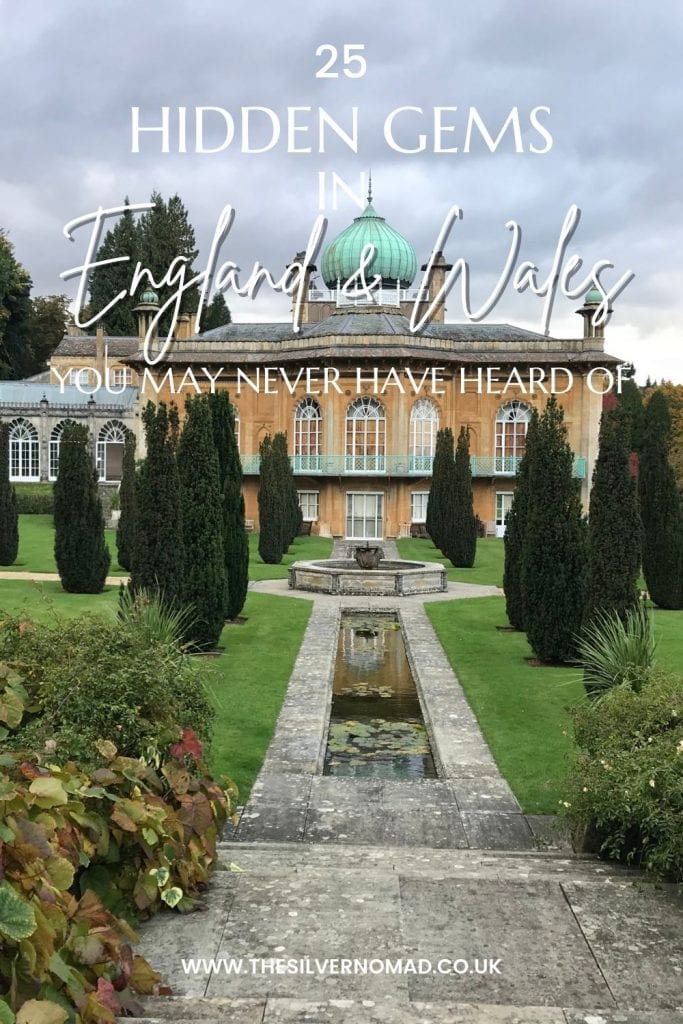
Hidden Gems in England and Wales
Malham, Yorkshire Dales

It is easy to see why the Yorkshire Dales were awarded the title of Best National Park in Europe by TripAdvisor. If you want to see the best of the Dales in one day, the village of Malham is the place to be.
Malham is a quintessential Yorkshire village where the pub and the local shop are the centre of activity. So why visit Malham? Because of the striking natural wonders nearby!
The pretty waterfall Janet’s Foss takes its name from Janet, queen of the fairies. Legend has it that she lives in the cave behind the waterfall. It is the ideal place to sit and admire the falls and take some photos. If you’re brave, you can take a bracing swim in the plunge pool.
From the realm of fairies to the land of giants. Gordale Scar is a narrow canyon that reaches hundreds of feet high. It is the ideal place to sit in the shade and enjoy a picnic.
Malham Tarn is located furthest from Malham village, so is usually the quietest. It is best enjoyed by a peaceful stroll around the lake.
Malham Cove is an 80m high cove with a limestone pavement at the top. If you’re an adrenaline junkie, you can climb the face of the cove. If not, you can climb the steps to the limestone pavement and take in the views!If you want to take in all four of Malham’s highlights in one day, you can enjoy this incredible circular walk.
by Hannah from Get Lost Travel Blog
Rievaulx Abbey, North Yorkshire

In a secluded valley in the North Yorkshire Moors National Park lies a lies a small village and the evocative ruins of Rievaulx Abbey.
Rievaulx Abbey was founded in 1132 and was the first Cistercian abbey established in the north of England. It quickly became one of the most powerful centres of monasticism in Britain, housing a 650-strong community at its peak in the 1160s. The monks were both powerful and wealthy due to their iron smelting works and the agricultural lands surrounding the Abbey.
The dissolution came in 1538, on orders from Henry VIII and the buildings were sacked and destroyed The ruined Abbey lands were given to the Earl of Rutland who was one of Henry’s advisors and in later years passed to the Duncombe family. The family continued on with the extremely valuable smelting works and the ruins were incorporated into the parkland of Duncombe Park.
After WWII, the smelting works closed and the village became agricultural. Many of the buildings, which had used the stones from Rievaulx Abbey to build, remain such as the old Watermill. The Miller’s Cottage is still standing and almost all the buildings in the village were built with materials scavenged from the ruin of the Abbey.
The Abbey ruins are maintained by English Heritage and the visitors centre, has a café and shop and a small Abbey Museum which has some wonderful finds on display from the site. These include a 14th-century carved frieze there’s a Green Man carving and some fragments of medieval glass from the Abbey Church.
by Faith from XYU and Beyond
Wells and the Mendip Hills, Somerset

Wells is nestled in the Somerset countryside at the bottom of the Mendip Hills. It is the smallest city in England, but has everything that any other city offers. It is a great area to visit as everything is fairly close together and the landscapes surrounding the city are stunning. At the top of the busy high street in the Cathedral. This has a unique vaulted ceiling, a medieval clock that is worth finding for its hourly chime and a beautiful chapter house and cloisters.
Adjacent to the Cathedral is Vicar’s Close the longest inhabited street in Europe while on the opposite side of the cathedral is the Bishop’s Palace. This fortified palace is home to the Bishop of Bath and Wells. It is surrounded by a moat and has beautiful gardens to explore. It is also the source of the springs which the city takes its name.
A short distance from Wells is Cheddar Gorge. This is the deepest gorge in England and has a road that runs through the length of the gorge. It is possible to stop at various places and look at the cliffs towering high above you. At the base of the gorge are the Cheddar show caves which are interesting to visit and deeper exploration can be arranged if you fancy some caving!
Beyond the gorge the hills are wild with beautiful walks and landscapes. Visitor numbers are small and it is a quiet area to visit.
by Suzanne from Meandering Wild
Hartland, North Devon
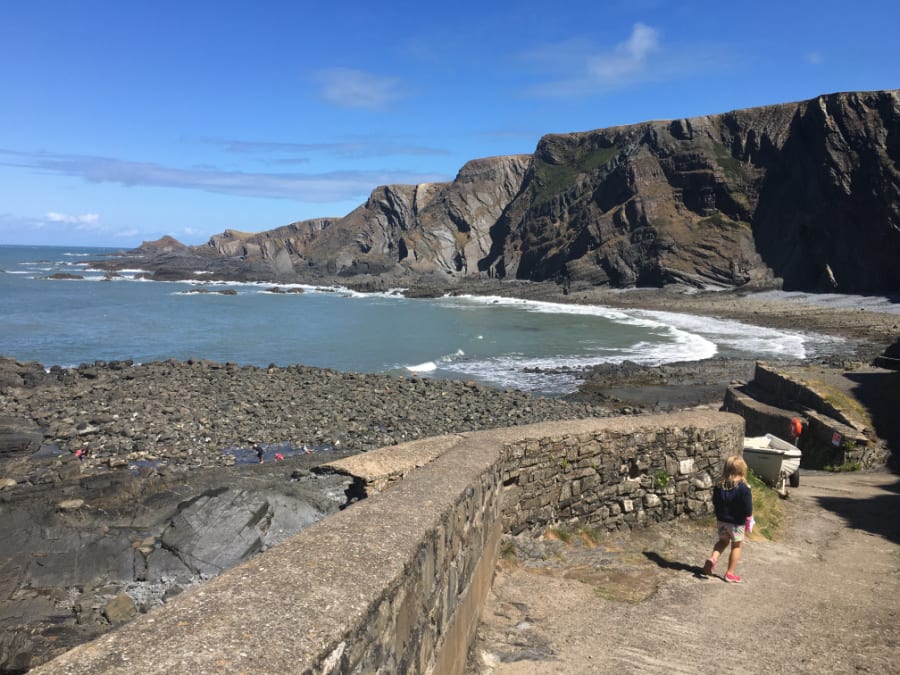
If you want to escape the hubbub of South West England’s holiday hotspots then Hartland in North Devon is the perfect hidden gem. It sits on a peninsular close to the border with North Cornwall and the dramatic Atlantic coastline.
One place where you can see the power of the ocean butted right up against the breathtaking geology is Hartland Quay. This was once a small harbour; the remains of which lay strewn around the base of the buckled and folded cliffs.
Somewhere else off the beaten track is Hartland Abbey. This former monastery turned stately home dates back to 1157. Unlike a lot of other historic houses you might visit in England, this one is still lived in by descendants of the family that moved in during the reign of Henry VIII. It is incredibly atmospheric and has recently been used as a set for the children’s TV show Malory Towers.
Here’s some more things to do around Hartland.
There are plenty of holiday cottages and B&Bs around the village of Hartland. If you are camping, Stoke Barton Campsite is a good place to pitch for easy access to the South West Coast Path.
by Claire from Devon with Kids
Amersham, Buckinghamshire
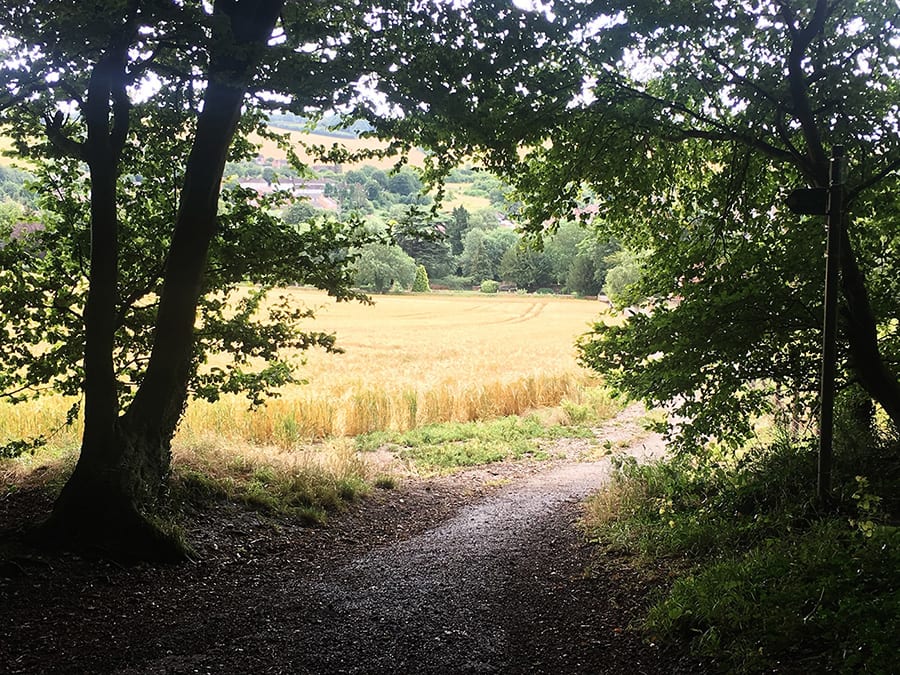
Millions of people visit London every year appreciating its modernity, eclectic patchwork of neighbourhoods, and traditions, but few decide to venture further to see another side of the English lifestyle in smaller villages such as Old Amersham.
Old Amersham is a delightful village that would be the perfect backdrop for Miss Marple’s adventures amidst flower-covered cottages, and traditional pubs with inviting gardens at any time of the year. You don’t need a great deal of organization to spend a lovely day there, from Baker Street and Marylebone Station there are direct connections that arrive in less than an hour, an easy trip to include even during a few days’ visit to London.
Pay attention when you arrive though or you may end up in the less interesting new part. Turn left out of the station, then as soon as you pass the overpass, take the small road to the right, between the buildings and the overpass. From here a 15 minute walk will take you to the oldest part of Amersham, leaving you feeling you are in the English countryside light years from the bustling capital.
Let yourself be guided by instinct, browse the small independent shops, or the market held in the protected Market Hall building, find out about the history of the place in the small museum, or relax on one of the benches in the Memorial Gardens. To eat you will have various possibilities between healthy cafes, traditional pubs, and even the starred Artichoke (but in this case, a reservation in advance will be required).
by Clotilde from A Princess Travelling with Twins
Mersea Island, Essex

Mersea Island on the Essex coastline is an absolute UK seaside gem that not many people know about.
Just a few hours outside of London, most people from the capital tend to head for the beaches of East Sussex or Kent, meaning Mersea Island tends to dodge the crowds – how delightful!
Adding to this delight are Mersea’s beautiful sandy shores, its small town relaxed vibe and, of course, its iconic beach huts, which make for the perfect summer snaps!
Top this off with some delicious seafood (don’t miss the famous Company Shed), tons of watersport activities and even a museum and historic town centre to visit, and you’ve got yourself a winner!
For Mersea Island day trips, it’s best to drive to the island or catch a train to Colchester and then grab a taxi.
Otherwise, if you’d like to stay overnight, this Grade II listed, 400 year old cottage (which combines period features and modern amenities) is hard to overlook!
by Steph from Big World Small Pockets
The Ridgeway, Wiltshire through to Buckinghamshire

The Ridgeway is a hidden gem in England that is in plain sight. Starting in the World Heritage site of Avebury in Wiltshire, The Ridgeway National Trail takes you 87 miles to the northeast ending in Ivinghoe Beacon in Buckinghamshire.
The route is the same one used by travellers, soldiers, herdsmen and trade from prehistoric times, and is known as ‘Britain’s oldest road’.
The trail takes you along the ridge of chalk hills through stunning countryside, grasslands habitats, the North Wessex Downs Area of Oustanding Natural Beauty, rolling hills and gentle valleys. As you walk you pass Stone Age long barrows, Iron Age forts, Bronze Age round barrows and chalk horses cut into the hill.
Depending on your walking speed, and how much time you take to enjoy the epic views, you can complete the 87 miles in around 6 days, or just do a section or two. You can see the route on the National Trail website. You can break your walk up with stops for refreshments along the way when you pass through villages and towns.
Although you can walk the Ridgeway any time of year, from May to September is the best time for the scenery and also ease of walking.
by Larch from The Silver Nomad
Truro, Cornwall

A highly underrated destination in Cornwall, and the only city in the county, is lovely little Truro! Known for the historic city centre with cobblestoned streets, cute cafes, and pretty boutique stores, Truro may be small but certainly deserves a spot on your Cornwall road trip itinerary.
If you love beautiful architecture, you can spend hours just wandering around town admiring Gothic and Georgian-style buildings.
One of the best places to visit in Truro is Truro Cathedral. This beautiful place of worship was built between 1880 and 1910. Admission is free but donations are appreciated. Also be sure to check out the Assembly Rooms, The Alverton Hotel, and Walsingham Place (though there are plenty of other noteworthy buildings in Truro).
For those interested in the mining and engineering history of Cornwall, a visit to the Royal Cornwall Museum is an absolute must. In this compact but well laid out museum, you can learn all about Cornwall and its important role in the Industrial Revolution.
A good place to have a cup of tea after exploring Truro, is Charlotte’s Teahouse, a cosy Cornish tearoom. For breakfast, brunch, or lunch, head to Bread & Butter for a stack of delicious fluffy pancakes, a generously topped toasted ciabatta, or a great salad.
By Lotte from Gezond Weekmenu
YOU MIGHT ALSO LIKE: Hidden Gems in Scotland and Northern Ireland
Lundy Island, North Devon

Lundy Island is one of North Devon’s best-kept secrets. It’s a two-hour ferry crossing from Ilfracombe or Bideford, and it sits majestically in the Bristol Channel, a rocky outcrop on its own that has now become a beautiful nature reserve.
Lundy has a long and intriguing history – it was privately owned for many years and was actually captured by pirates and was a hotbed of smuggling for a while! But since the Victorian era, it has become a wonderful holiday destination. A walking tour with a local ranger will detail the intriguing history of the island.
Because of its position at the meeting point of the Bristol Channel and the Atlantic Ocean, Lundy Island is home to a range of marine, bird and mammal life. You can do a snorkelling tour to see the local seal colony – they’re a friendly bunch who will swim very close to you! There are also boat trips around the island. Also, look out for Lundy puffins, who have become the icon of the island, and ponies on land.
Lundy also has the oldest private postal service in the world, so make sure that you send yourself or a loved one a postcard with a unique Lundy stamp, before enjoying a drink in Lundy Island’s only tavern!
You can either do a day trip to Lundy Island or book accommodation via the Landmark Trust. Do be aware that the crossings are weather dependent, so if it’s raining when you’re in Devon your trip might be cancelled (you’ll get a refund if this is the case) or postponed.
By Claire from Go South West England
Shrewsbury, Shropshire

If you’re interested in history, Shrewsbury is a great place to visit. It’s one of the most complete medieval towns in England with its castle and ancient buildings that have been around for centuries. The town has undergone many changes over time, but it still retains much of its original charm.
Shrewsbury is also a great destination if you’re looking for something different to do or want an escape from London life!
There are many things to do in Shrewsbury. There are plenty of museums and galleries to explore, as well as a host of activities you can enjoy all year round. Even strolling through small narrow streets is an experience on its own.
If you want to rest go to the Quarry – a beautiful park located in the middle of Shrewsbury between the Old Town and River Severn. You can have a picnic here or go for a boat ride.
The Shrewsbury Folk Festival is one of the most popular annual events, attracting visitors from all over to enjoy traditional folk music.
Shrewsbury has a thriving art scene as well, with many theatrical performances and festivals throughout the year. One of the best ways to explore this hidden gem in England is on foot or by bike. Beside the town, you’ll find green rolling hills and the beautiful countryside.
Shrewsbury is the perfect destination for all seasons and occasions. It’s a town that will charm you with its hidden gems time after time while tempting you to explore further into this corner of England.
by Ania from The Travelling Twins
Robin Hoods Bay, North Yorkshire

The small, car-free fishing village of Robin Hoods Bay lies on the North Yorkshire coast near Whitby. Visitors must park in the designated car park at the top of the hill and make the steep walk down into the village.
Wandering around the atmospheric lanes of Robin Hoods Bay feels like stepping back in time. Narrow cobbled lanes criss-cross the village and are lined with tightly packed individual cottages dating back over two hundred years. Vibrant window boxes, low wooden front doors, hidden steps and Victorian lamp posts add to the charm of Robin Hoods Bay. You will enjoy getting lost in the maze of lanes.
After exploring the village, head down to the expansive sandy beach and drop into the free to enter Old Coastguard Station that contains displays about the history and geology of the area. Robin Hoods Bay is part of Yorkshire’s Jurassic coastline and eagle-eyed visitors can find ammonites, belemnites and Devil’s Nail fossils on the beach.
Due to the lack of parking near the beach, visitors making the trek to the sand are rewarded with lots of space and peace. The village also lies on the Cleveland Way National Trail and offers fantastic, easy to follow coastal walks in either direction; the stretch to nearby Whitby is particularly scenic. It is also the endpoint of the epic 192-mile Coast to Coast trail.
Stay at The Bay Hotel, a 200-year-old cosy pub and restaurant with an unbeatable position right on the seafront.
by Sinead from Map Made Memories
Cannock Chase, the Midlands
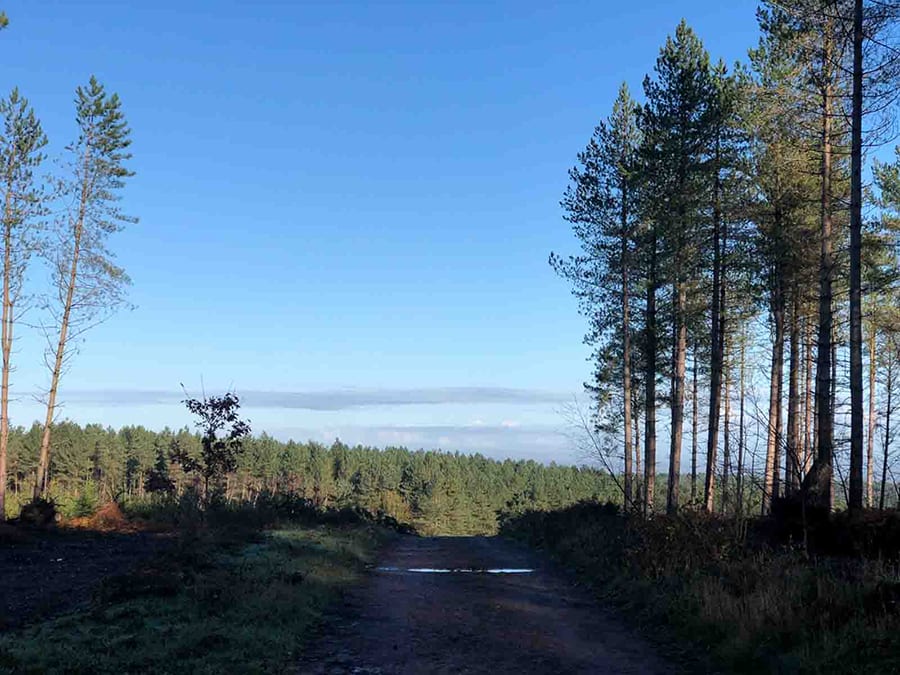
The often-overlooked middle Counties of the UK are home to some of the most breathtaking scenery in the Country. Cannock Chase is the perfect place to soak in the beautiful Midlands countryside.
Cannock Chase is one of the UK’s smallest Areas of Natural Beauty, coming in at just 26 acres. What it lacks is size it definitely makes up for in outdoor activities. Home to miles of walking trails, cycling routes and bridleways. Families will love the many child friendly play areas, fairy village and Gruffalo trail. Whilst thrill seekers will be delighted by a walk in the treetops at Go Ape or a Segway ride through the forest.
The area is home to the National Trusts Shugborough Estate, a stunning Georgian Mansion House with grounds. At over 300 years old this is a must visit for history lovers.
Head to Birches Valley, Cannock Chase for organised activities and well marked trails or further into the forest to explore the many war memorials and off the beaten path tracks. Cafes at Fallow Forest and the Birches Valley Carpark are perfect for fuelling up after your hike. A visit to Cannock Chase really does have it all.
For a luxury hotel stay in the area book in to Hoar Cross Hall. A lavish five-star Hotel and Spa located in the Staffordshire Countryside just twenty minutes from Cannock Chase.
by Karen from Marvellous Middle England
Sezincote, Gloucestershire

On the outskirts of Moreton-in-Marsh is the stunning country estate of Sezincote. Not only is Sezincote set in beautiful grounds stretching 3,500 acres, but surprisingly for the Cotswolds, it is built in neo-Mughal style. An Indianesque house in the heart of chocolate-box houses? But it works.
The house dates back to the early 19th Century when Charles Cockerell inherited the estate from his elder brother. Both brothers had served in East India Company army and brought their love of the country back to England.
The design of the house is a blend of Hindu and Muslim influences. The house is topped off with an onion dome, a soft green of weathered copper. The curving orangery to the side has a wall of flowers including passionfruit vines, oranges and blue ceanothus.
The landscaped grounds include seven pools, waterfalls, a temple to the Hindu Sun God, Surya and a grotto. Even the bridge leading to the house is adorned with Indian Brahmin bulls. A walk around the gardens is a must to explore and, when open, the house has splendidly ornate rooms.
You can book a visit to the house and gardens on the Sezincote website.
by Larch from The Silver Nomad
YOU MIGHT ALSO LIKE: 35+ Amazing Hidden Gems in Europe
St Albans, Hertfordshire

St Albans is a place steeped in history, just 20 miles north of London. St Albans Cathedral is the focal point of the city & home to the shrine of its namesake, the first ever British saint. At 85 metres, the cathedral’s Nave is the longest in England & decorated in one of the most extensive displays of medieval murals anywhere in the country. The cathedral sits among 100 acres of tranquil Verulamium Park.
Verulamium also has many hidden gems as the park contains numerous remnants of its former glory as an important Roman settlement. The city walls & London Gate are easily explored on any stroll around the park. In addition, it is home to an exquisitely preserved mosaic & hypocaust (central heating system) which has stood in this location since 200AD. Close by is yet more ancient history in the form of a roman theatre. It is unique to Britain as the only structure of its kind with a stage instead of an amphitheatre.
St Albans is also the perfect place to visit if you want to sample some of the UK’s best hospitality. It is the base of the Campaign for Real Ale & famed as the city with the most pubs per head of population (95 at last count!). This includes Ye Olde Fighting Cocks, renowned as the oldest pub in England. With all those pubs to explore, you may want to stay overnight & if so, the centrally located Clarion Collection will fit the bill perfectly.
by Sue from Sue Where Why What
Cambridge and the surrounding villages, Cambridgeshire
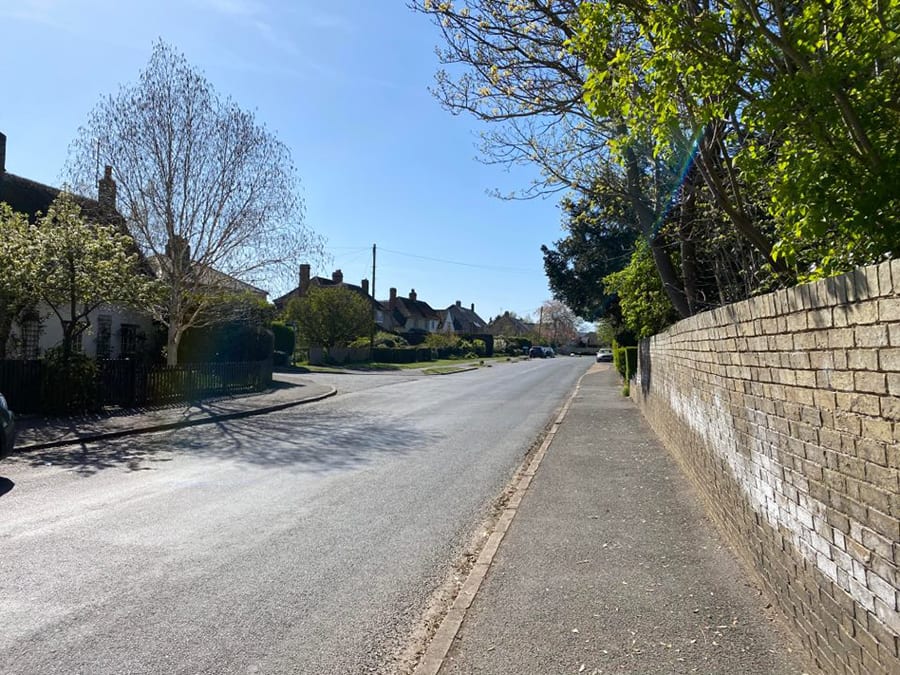
Cambridge is an amazing city with a lot to offer. Whether you are interested in the history, culture, or people of Cambridge, there is something for everyone. But what about those days where you want to get away from it all? You could take a trip outside of town and explore some of the beautiful villages that surround Cambridge!
What better way to spend your day than admiring the beauty that this part of England has to offer? With so many different things for visitors and locals alike to do in these small towns, there’s no reason not to!
Each of the many villages surrounding the beautiful city has its own unique character. These towns are in close proximity to the city but still have a small-town feel you’d expect from picturesque English countryside gems. This is what makes them perfect for all travellers out there looking for an authentic English experience, or wanting to visit some of the cute hidden gems in the UK.
Some of the best villages surrounding Cambridge are St Ives, Granchester, Fenstanton, Dry Drayton, and Comberton. There are also plenty of green spaces, parks and walking routes around Cambridge if you enjoy getting out into the great outdoors, perfect for combining with these beautiful places.
by Alice from Adventures of Alice
Ventnor, Isle of Wight
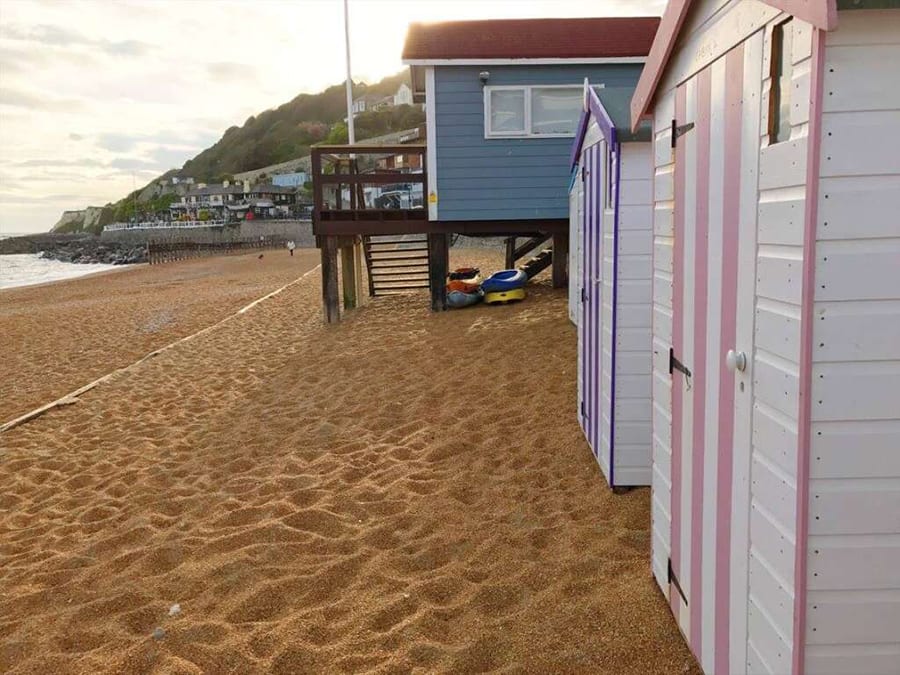
Ventnor on the Isle of Wight is one of the hidden gems in the UK and well worth spending as long as possible in. Situated at the south of the island it still retains a Victorian feel and is reminiscent of holidays from yesteryear. Indeed Ventnor has been welcoming holidaymakers for centuries and it’s got an air of refined beauty about it.
The main reason to visit the town is for its beautiful beach with ice cream-coloured beach huts lining it. You can almost imagine the bathers and sun seekers from a hundred years ago taking to the water here in their bathing machines which have now been converted into the beach huts you can see today.
There’s a traditional arcade here which is one of the fun things to do in the Isle of Wight with kids, as well as a bandstand and harbour. There are some gorgeous grounds too, from Cascade Gardens to the Victorian Ventnor Park. There’s a scattering of shops and restaurants along Ventnor esplanade making it a great place to come and spend a day.
There are also some very sweet hotels if you can stay longer and really relax in this little hideaway town. There’s something distinctly Mediterranean about Ventnor, it is somewhere that feels warm and inviting.
by Nichola from Globalmouse Travels
Halnaker Windmill, West Sussex

Seeing Halnaker Windmill is the reward you get after you finish the “Windmill Trail”, which starts in the beautiful village of Boxgrove, near Chichester. Getting to the start of the trail is fairly easy, both by driving and by public transport, with plenty of buses leaving the train station in Chichester towards Boxgrove and Halnaker. Parking is free of charge at the village hall, in Boxgrove.
To get to Halnaker Windmill you will have to walk on the ancient 57 mile long Roman Road that used to connect London to Chichester. Today, this part of the road is just a beautiful trail, passing underneath one of the most beautiful tree tunnels in England. In fact, many people do this trail so that they can experience the Halnaker Tree Tunnel that leads towards the Windmill.
Halnaker Windmill has been built sometimes around the 16th century, but the first official mention of it comes from 1850. Back then, the windmill was made entirely from wood. It was built for the Duke of Richmond, as the feudal mill of his estate. The windmill was functional until 1905, when it was struck by lightning. Its sails and windshaft were damaged, which out it out of business for good. The Halnaker Windmill has been renovated several times over the years but was never used again.
Halnaker Windmill is located on top of a hill and offers stunning views over the countryside, all the way to the sea on clear, sunny days.
by Joanna from The World in My Pocket
YOU MIGHT ALSO LIKE: 20+ Best Staycations in England
Alfriston, East Sussex

In the heart of the East Sussex countryside you’ll find the pretty little village called Alfriston. Full of character and medieval charm, this lovely village dates back to the 14th century. It may not be as well known as some of the more popular villages in England however with its beautiful historic buildings and fascinating history, Alfriston is sure to steal your heart.
As you wander along the picturesque high street, take your time exploring the little shops, tea houses, and well preserved pubs. Make sure to visit The Clergy House, this is the most well known building in the village. It’s half-timbered, thatched, surrounded by pretty gardens and very much in the same condition as it was over 600 years ago. Entering the house will offer an excellent insight into a medieval villager’s life.
A trip to Alfriston wouldn’t be complete without stopping for a traditional pub lunch at the Star Inn. This beautiful old pub dates back to the 15th century and retains much of its original features such as oak beams and large open fires. The George Inn across the street is equally charming and also makes for a great place to stop and break up a day of sightseeing.
If you plan to spend the night in Alfriston, then you shouldn’t look further than Ye Olde Smugglers Inne. This is a cosy old inn steeped in history and features vintage decor and a charming ambience. It’s the perfect choice for your visit to this wonderful historic town.
by Ann from The Road Is Life
The Bear Pit, Sheffield

When looking for hidden gems in the UK you may be surprised to find out that somewhere in Sheffield you can find the home to a real-life black bear. Although this bear no longer resides there, you’ll find a larger-than-life statue in memory of the fully grown mammal.
The Grade II listed structure built back in 1836, which is still in superb condition today, was built specifically to house this bear. Today you find a 2.4-meter tall statue.
As one of the many free things to do in Sheffield, you can expect to have a fun day out without spending a penny. From the city centre head to the Botanical Garden on Ecclesall Road to start your quest on finding the bear pit.
You’ll be surprised by just how realistic the bear looks with its super realistic grizzly-brown colouring and fine fur detailing. Other things to do whilst in the Botanical gardens include exploring the greenhouses which are home to some of the most beautiful plant specimens. You can also enjoy the view of a beautiful-looking pond that offers you a relaxing moment or two. All in all, as far as hidden gems go, this one place you will not miss if you find yourself in Sheffield.
by Daniel from Urban Abroad
Wycoller, Lancashire

In a hidden valley between Lancashire and West Yorkshire, you’ll find Wycoller. Wycoller is a tiny hamlet, set picturesquely beside a stream and made up of covetable, honey-coloured houses with pretty cottage-style gardens, but for such a small place, there’s a lot to see.
The one thing you can’t miss when you visit Wycoller is the ruins of Wycoller Hall. The Hall was built in around 1550 and was expanded and adapted over the centuries, most notably in the early 1800s when the last inhabitant, Henry Owen Cunliffe remodelled the Hall in the style of a grand manor house. He died in 1818, deeply in debt, and the Hall fell into ruin – but that’s not the end of its story. In the mid 1800s Charlotte Brontë lived across the moor in Haworth and often travelled through Wycoller. It’s believed that Wycoller Hall inspired Ferndean Manor in her novel Jane Eyre.
Once you’ve explored the Hall, head up the hill behind it to see Wycoller’s other standout attraction. The Atom Panopticon is one of four art installations across East Lancashire and this is the most stunning. The Atom looks like an alien egg dropped onto the hilltop, with oval windows that frame the beautiful views.
From the Atom, take one of the many lovely walks back to Wycoller and see the seven historic bridges which cross the Wycoller Beck. Explore the willow arches by the stream and look out for fairy doors set into the trees around the village.
by Helen from Helen on Her Holidays
Lizard Peninsula, Cornwall

An Area of Outstanding Natural Beauty (AONB), the Lizard peninsula in Cornwall has one of the most diverse landscapes in the U.K. It is here that you will also find basalt rock columns rarely found elsewhere in the world!
It has beaches and coves and fishing villages, making it the perfect getaway in Cornwall.
The fishing ports are colourful and full of life and, of course, alive with the smell of fresh fish and chips. You’ll also find many shops here that sell scones and freshly baked Cornish pasties (with steak and ale being very popular) that make for tasty treats. Anne’s pasties have been around for years and are one of the best spots to grab one. The shop is also located at England’s southernmost point. You can end your meal with some fresh homemade ice cream at Roskilly’s farm.
Some of the places you should visit here are the village of Cadgwith, Kynance cove, Coverach beach, Kennack sands and Poldhu cove beach. At Lizard lighthouse, in addition to striking views, you will be able to learn about the maritime history of the area.
At most of the beaches here, you will be able to train to dive (and go diving too), in addition to kayaking, and in some places even surfing.
In spring and summer, the area is covered with some of the rarest plants and flowers, making it very pretty to take a walk in Lizard.
by Lavinia from Continent Hop
Amberley, West Sussex
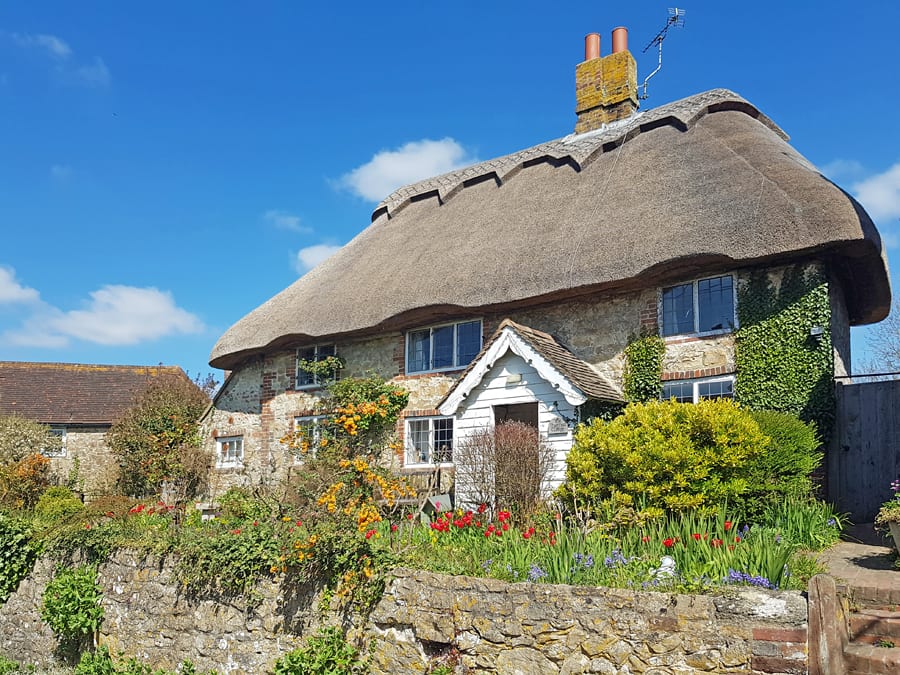
Amberley in West Sussex is one of the prettiest villages in England with a ruined castle, more than its fair share of historic, thatched cottages, and a fabulous open-air museum.
In the village, you’ll find a café, a grocery store and a pottery workshop – the perfect place to pick up a unique gift or souvenir. The village pub, The Black Horse, has a spacious outdoor seating area with a view of the surrounding hills. The food and service are excellent. They also have a number of rooms for overnight stays.
Located in the South Downs National Park, just four miles north of Arundel, there is no end of beautiful walking routes leading from the village. The South Downs Way, a 100-mile footpath and bridleway leading from the Winchester in Hampshire to the Seven Sisters in East Sussex passes just south of the village.
Amberley Museum a short walk from the village, is set in a former chalk quarry. It makes a fascinating day out for all the family with a narrow-gauge steam railway, vintage vehicles, historic buildings and exhibitions.
At the far end of the village, looming up behind the 12th-century church of St Michael, the walls of Amberley Castle are an impressive sight. The castle is now a luxury hotel with many of the guest rooms located in the historic manor house within the castle walls. As well as a superb afternoon tea (which can be gluten-free on request), the castle’s restaurant serves wonderful lunches and evening meals. If they have no large bookings, you can pop by just for a coffee and slice of cake and have a stroll around the castle grounds, but it is advisable to ring ahead.
Amberley is easy to get to by road or by rail with direct trains from London taking about 2 hours. The railway station is about a one-mile walk from the village centre.
by Kathryn Burrington from Sussex Walks
Whitley Bay, Tyne and Wear

Northumberland in the UK is more or less the Scotland of England, being at the border of England and Scotland. The landscape here is breathtaking and there is a lot to explore here with mountains, wildlife, castles and coastal towns.
Whitley Bay in Tyne and Wear, on the border of Northumberland is a small coastal town very close to the city of Newcastle Upon Tyne and offers a splendid coastal experience with breathtaking scenery and other attractions.
Things to do in Whitley Bay range from enjoying the stunning beaches and coastal attractions like watching the ships and lighthouses in the north sea, enjoy fishing or surfing and even have some fun at aquariums and golf. The main beaches here are Whitley bay beach, Cullercoats beach and Long Sands beach, where you can even see surfers enjoying their sport with the waves.
Tynemouth priory and castle is located beside the Tynemouth offering a stunning view near the sea. This is part of English Heritage and entry tickets are available to go inside the castle and priory.
St Mary’s lighthouse is one of the best in this area, with a gorgeous lighthouse and cove where you can even see some wildlife like seals on a sunny day. The beach is pretty scenic and the rocks here are suitable to take small walks on them. The best time to visit is sunrise to enjoy the amazing view of the lighthouse.
There are many places to eat and stay along the Whitley Bay beach, which makes this town a must-see during your Northern England trip. Whitley Bay has a metro connection to arrive here and major attractions are walkable from the metro station, making it perfect for a day trip from Newcastle Upon Tyne or Tyne and Wear.
by Jumana from Planet Hopper Girl
Scotney Castle, Kent
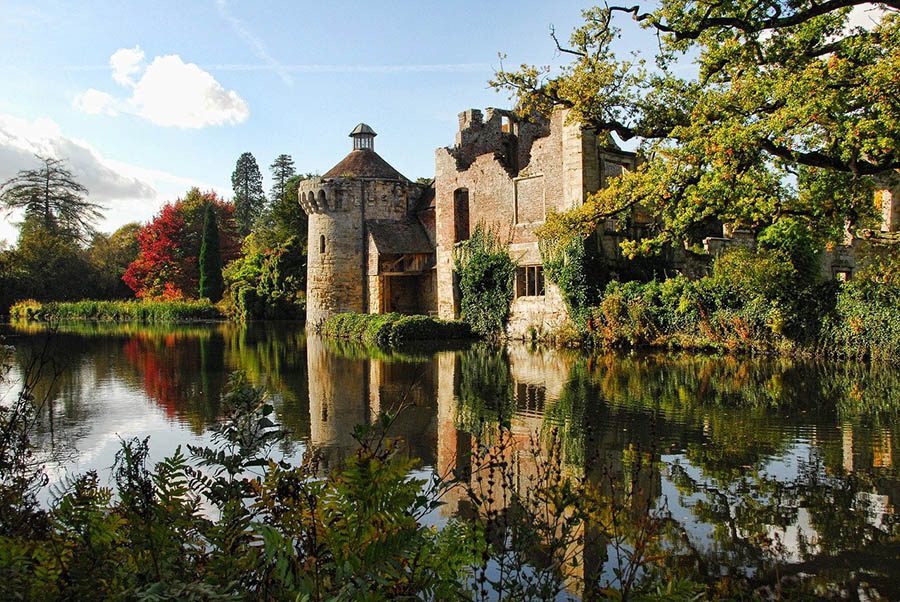
Scotney Castle is a real gem that offers a really beautiful experience when it comes to English countryside estates. The castle not only offers history but also a deeper insight into Victorian society and massive sprawling gardens. These gardens are romantic to every inch and the castle offers a beautiful backdrop to the stunning scenery around.
The nearest town to Scotney Castle is Royal Tunbridge Wells. It is quite easy to reach there via train from London and also within Kent County.
The castle has two parts, the most beautiful (and instagrammabale) part is the old castle which are the ruins of the old house built on an island in the lake surrounded by serene wooded gardens. The lake and gardens are also stunning because it has flowers for all seasons. The best time to enjoy the scenery is summer and autumn though.
The new part of the estate is a house built in a Tudor revival architectural style in 19th century. It is called the Scotney New Castle. It is used as a set for period dramas as well and is very beautiful.
The estate has a huge area devoted to gardens and woodlands, some 700 hectares of it. Whether you are going with your family, partner or friends or just yourself, it is a beautiful place to enjoy a lovely walk in, it is picture-perfect and very soothing.
Despite its 14th century label, the castle has all the charm of a Victorian architectural and horticultural masterpiece.
Scotney Castle is part of the English National Trust. It is advisable to book yourself a visit to avoid disappointment when you arrive as it is a popular spot.
by Ucman from Brown Boy Travels
YOU MIGHT ALSO LIKE: 7 of the Best Staycations in Wales
Hay on Wye
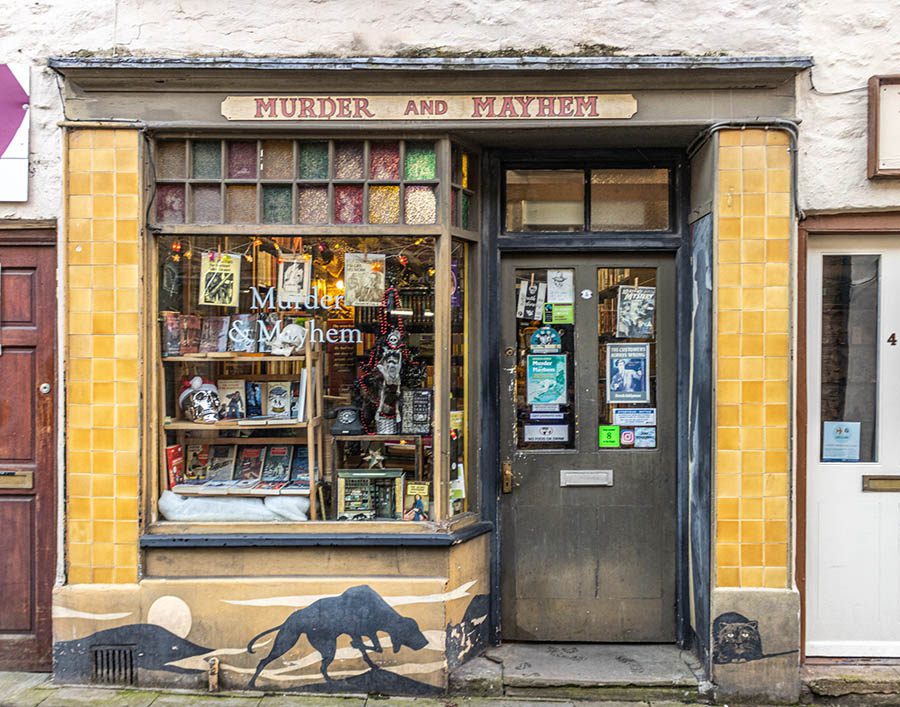
Hay on Wye is a tiny book town in Wales that is an absolute must for literary travellers. The main activity in Hay-on-Wye is, as you’d expect, book shopping. The town is really very small and you could walk from one end to the other in about 10 minutes. It might surprise you, then, that there are over twenty bookshops in this very small area.
There are bookshops old and new selling every genre you can think of. There are even outdoor bookshops where the books are almost completely exposed to the elements. There really are books everywhere. And the best part? The majority of the books sold here are incredibly cheap.
Some of the absolute best Hay-on-Wye bookshops to visit include Richard Booth’s, one of the larger bookshops with very pretty exteriors (and interiors!) and an accompanying cinema. There’s Hay Cinema Bookshop, the biggest of them all, with an unparalleled collection of second-hand books.
For bookshops with character, there’s Addyman Books, which is known for its room full of old Penguin classics. One of the more unique sights is the bookshelves lining the old walls of Hay Castle. You’re unlikely to find anything you’ve heard of here but it a gorgeous display of books.
For refreshments, Shepherds Ice Cream serve delicious ice cream flavours and creamy hot chocolate making it the perfect place to stop after a long day of book shopping. Or, if you fancy a cold pint and hearty meal, the Old Black Lion is a lovely establishment too.
By Laura of What’s Hot?
I hope you have enjoyed learning about some of the amazing hidden gems in England and Wales to explore and visit when you are having a holiday in the United Kingdom.
Don’t forget to pin this article so you can come back to it later

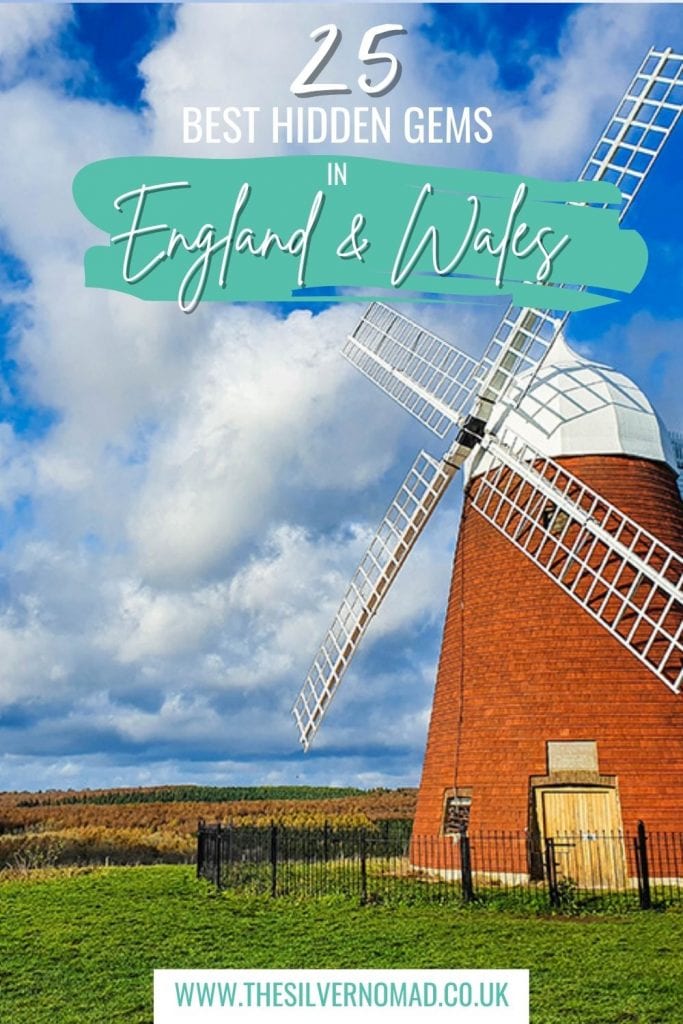






Thanks for informative article
perfect article thanks for sharing it with us
My pleasure Gerald
England and Wales has a multitude of hidden gems that I’d love to explore. Love the scenery and the beautiful castles and gardens.
There is so much to see Alma, I hope you get to see some of it.
We do love to get off the beaten path when we travel. So great to get a list of gems to add to our travel plans when we get back to England. And Wales is a whole new spot for us. I love the mix of outdoor spots and fascinating architecture. And a few good food and drink tips too!
There always to be a new place to discover everytime I travel in the UK